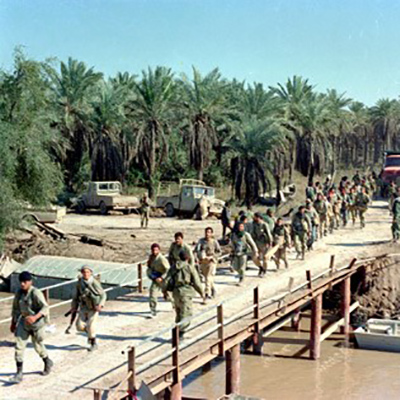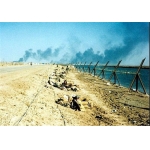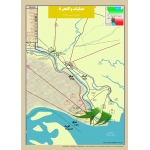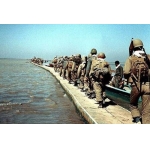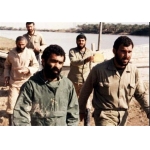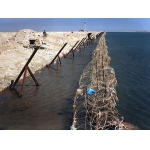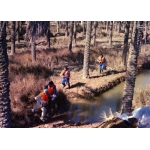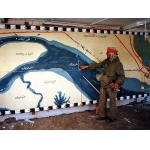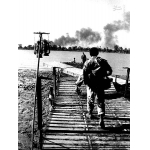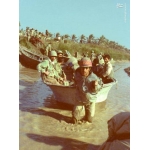Operation Valfajr 8
Leila Azadeh
215 بازدید
Operation Valfajr 8 was launched on February 9, 1986, with the code-name “Ya Fatemeh al-Zahra (s)”, with the Iranian forces crossing the Arvandrud River in southwestern Iran. This operation led to the capture of the Faw Peninsula and cut Iraq’s connection to the Persian Gulf.
The Faw Peninsula is located at the southernmost point of Iraq. The apex of this triangular region, which extends to the Persian Gulf, is called Ras al-Bisha. The peninsula is bordered by the Khor Abdullah and Arvandrud waterways on two sides, with its third side connecting to the outskirts of Basra. Natural features such as roads, embankments, earthworks, missile launch platforms, and oil facilities of the city of Faw were situated in this region, with much of the terrain being marshy. The semi-industrial city of Faw was the main battlefield with key strategic points including a salt factory, two roads connecting Faw to Basra, and a road linking Faw to Umm al-Qasr.[1] The distinctive features of the Faw region as the operational area of Operation Valfajr 8 were the existence of water on three sides, the ability to engage Iraqi forces from only one direction, and the capacity to deliver intense artillery and weapon fire on enemy troops from Abadan to Faw.[2]
The objectives of Operation Valfajr 8 included capturing the city of Faw to gain a strategic advantage for ending the war, approaching the borders of Kuwait which was financially and militarily supporting Iraq in order to pressure the international community into recognizing Iran’s rights, controlling Khor Abdullah to block Iraq’s access to the Persian Gulf, seizing missile launch platforms in the Faw Peninsula that threatened ships bound for Iran, and securing Khor Musa and the northern Persian Gulf to ensure safe maritime traffic to the Imam Khomeini (ra) Port.[3]
The operation had four phases:
1. Crossing the Arvandrud River by assault troops, breaching the enemy’s first line of defense, and securing the captured bridgehead with the support of divers;
2. Capturing the city of Faw, reaching Khor Abdullah, and establishing positions in the triangular area north of Faw—formed by the intersection of the Al-Bahar, Faw-Basra, and Umm al-Qasr roads—as well as securing the second missile base northwest of Faw;
3. Advancing assault units and support forces to the perimeter of the salt factory and establishing a defensive line along this area from the Arvandrud shore to Khor Abdullah;
4. Reaching the end of the salt factory grounds and the canal behind it along the Umm al-Qasr Road.[4]
The Islamic Revolutionary Guard Corps (IRGC) directed Operation Valfajr 8 with two command headquarters: Karbala and Nouh.[5] The IRGC Ground Forces assigned the attack from south of Faw to the tip of Ras al-Bisha to the Nouh Headquarters, and from south of Faw to the northernmost point of the operational area, including the capture of the city and the salt factory, to the Karbala Headquarters. The Raad Headquarters was responsible for air support, while the Soleiman-Khater Headquarters handled logistical support for maneuver units. The Najaf Headquarters was tasked with carrying out a supporting attack on Umm al-Rasas Island.[6] The subsidiary Yunus 1 Headquarters, under the Nouh Headquarters, was assigned to capture the Al-Umayyah dock with the Kowsar Naval Brigade, while the Yunus 2 Headquarters of the Army Navy, under the Khatam al-Anbiya (pbuh) Headquarters, was tasked with capturing the Al-Bakr dock.[7]
Being positioned in the northern axis of the operation, The Karbala Headquarters included the 5th Nasr, 7th Vali-e Asr (as), 8th Najaf Ashraf, 14th Imam Hussain (as), 17th Ali ibn Abi Talib (as), 25th Karbala, 27th Muhammad Rasulullah (pbuh), and 31st Ashura divisions, as well as the independent 15th Imam Hassan (as), 32nd Ansar al-Hussain (as), and 44th Qamar Bani Hashem (as) brigades. The Nouh Headquarters, in the southern axis, comprised the 19th Fajr and 41st Tharallah (as) divisions and the independent 33rd al-Mahdi (as) brigade. Also, the Quds Headquarters, as the supporting unit, included the 21st Imam Reza (as), Seyyed al-Shuhada (as), and the 18th Al-Ghadir brigades. All the above-mentioned headquarters were under the central command of the Khatam al-Anbiya (pbuh) Headquarters, forming the operational structure of Valfajr 8. In total, 140 Iranian combat battalions and 220 Iraqi battalions participated in the operation.[8] To deceive the enemy, limited attacks were conducted by the IRGC and Army several days before the main operation, in the Hoor, Shalamcheh, and Umm al-Rasas areas.[9]
The main operation began at 10:30 PM on February 9, 1986, with the code-name “La Hawla wa la Quwwata illa Billah al-Ali al-Azim wa Qatiluhum hatta la Takuna Fitnah” and “Ya Fatemeh al-Zahra (s), Ya Fatemeh al-Zahra (s)” across three fronts.[10] The first one was the Arvandkenar area, in which the Iranian forces sought to capture Faw and advance along the Abul-Khasib Road towards Basra as the main attack. Shalamcheh was the second front where a limited supporting offensive was carried out by the IRGC. The third battle area extended from Shalamcheh to Kushk along a 50-kilometer frontline, with a supporting attack by five Army Ground Forces divisions.[11] The main operation in Faw began with divers crossing the Arvandrud River while the enemy was caught off guard, swiftly expanding the captured bridgehead. Furthermore, Ras al-Bisha, the salt factory, missile sites, and Faw city were captured, and Iranian forces prepared to counter enemy counterattacks. Then, Iraq rapidly deployed its Presidential Guard units to delay Iranian advances and buy time for reserve units. However, the Guard units failed to hold the liberated positions and therefore disintegrated and retreated. The arrival of Iraqi reserve units was ineffective, and their 75-day counterattacks only increased their casualties and losses. Finally, the Iraqi commanders realized that efforts to retake Faw were futile and would only lead to further unit destruction, halting the counterattacks. Consequently, Iraq’s coastline along the Persian Gulf and its border with Kuwait remained under Iranian control.[12]
The engineering and support units of the Jahad-e Sazandegi Organization were responsible for preparing the operational area, constructing 473 kilometers of new roads in the Arvandrud region by using about 400 dump trucks, numerous loaders, and bulldozers, and repairing and paving 110 kilometers of existing roads. The Construction Headquarters of Jahad-e Sazandegi Organization built a field hospital, chemical decontamination sites, artillery and missile positions, communication roads, helicopter pads, embankments, and defensive trenches.[13]
The Iraqi army employed three tactics to dominate the Arvandrud coast and expel Iranian forces from Faw: extensive use of chemical weapons, widespread air attacks, and continuous shelling of the Abadan Road in Khosrowabad. Three days after the operation started, on February 12, 1986, 32 Iraqi aircraft chemically bombed the Faw operational area for an hour, injuring 2500 people on the first day. Two days later, 8500 more were injured due to the persistence of mustard gas. On the morning and afternoon of February 13, Faw and Abadan faced two heavy chemical attacks, resulting in the martyrdom of 20 Iranian fighters.[14]
In this operation, over 50000 Iraqi personnel, including 1 division commander, 5 brigade commanders, and numerous senior and junior officers, were killed or injured, with 2105 taken prisoner, including several staff colonels, lieutenant colonels, majors, junior officers, pilots, and non-commissioned officers. The enemy lost 39 aircraft, 5 helicopters, 300 tanks, 240 armored personnel carriers, 5 engineering vehicles, 250 vehicles, 150 field artillery pieces, 55 anti-aircraft guns, and 2 missile boats, while Iranian forces captured 50 tanks, 45 armored personnel carriers, 30 engineering vehicles, 180 vehicles, 20 field artillery pieces, 120 anti-aircraft guns, and 3 missile radars.[15] Nearly 10000 Iranian forces were martyred or injured. Four Army Air Force F-5 aircraft were hit, with some pilots martyred or captured.[16] The Army Aviation pilots flew 3938 hours, transported 1624 personnel to Faw, evacuated 2038 wounded to the rear, and carried 330 tons of light and heavy equipment. In addition, Cobra attack helicopters fired 67 TOW anti-tank missiles, 4 Maverick heavy missiles, 841 rockets, and 5280 20 mm cannon rounds at Iraqi tanks, personnel carriers, vehicles, missile sites, and troops.[17]
All designated objectives were fully achieved. Approximately 30 square kilometers of Iranian territory were liberated, 770 square kilometers of Iraqi territory were captured, and Iraq’s access to international waters was cut. Faw city and its docks were seized, and Iranian forces positioned themselves 20 kilometers from the Umm al-Qasr port.[18]
To commemorate the heroes of this operation, the Valfajr 8 Martyrs’ Memorial was built by the Foundation for the Preservation of Sacred Defense Works and Values near the Arvandrud River, across the Iraqi Faw city, and on the northern shore of Arvandkenar. In this memorial, five unidentified martyrs who sacrificed their lives during this operation are buried.[19]
[1] Mabudi, Jalal, Atlas Lashkar 31 Ashura dar Doran-e Defa-e Muqaddas (Atlas of the 31st Ashura Division during the Sacred Defense), Tehran, Markaz Asnad va Tahqiqat Defa-e Muqaddas, 1398, p. 162; Zarezadeh, Nader, Atlas Lashkar 17 Ali ibn Abi Taleb (as) dar Doran-e Defa-e Muqaddas (Atlas of the 17th Ali ibn Abi Taleb (as) Division during the Sacred Defense), Tehran, Markaz Asnad va Tahqiqat Defa-e Muqaddas, 1399, p. 218.
[2] Ardestani, Hussain, Tajzie va Tahlil-e Jang-e Iran va Araq: Tanbih-e Motajavez (Analysis of the Iran-Iraq War: Punishment of the Aggressor), Vol. 3, Tehran, Markaz Motaleat va Tahqiqat-e Jang, 1379, p. 169.
[3] Habibi, Abolqasem, Atlas Khuzestan dar Jang-e Iran va Araq (Atlas of Khuzestan in the Iran-Iraq War), Tehran, Markaz Asnad va Tahqiqat Defa-e Muqaddas, 1393, p. 203.
[4] Alai, Hussain, Tarikh-e Tahliili-ye Jang-e Iran va Araq (Analytical History of the Iran-Iraq War), Vol. 2, Tehran, Marz o Bum, 1395, Pp. 175–176.
[5] Zarezadeh, Nader, ibid., p. 219.
[6] Mabudi, Jalal, ibid., p. 162.
[7] Pourjabbari, Pejman, Atlas Joghrafiya-ye Hamasi – Khuzestan dar Jang (Atlas of Epical Geography– Khuzestan in War), Vol. 1, Tehran, Sarir, 1389, p. 100.
[8] Habibi, Abolqasem, ibid., p. 204.
[9] Rashid, Mohsen, Atlas Jang-e Iran va Araq (Atlas of the Iran-Iraq War), Tehran, Markaz Motaleat va Tahqiqat-e Jang, 1379, p. 74.
[10] Karimzadeh, Ardeshir, Hamaseh-haye Mandegar-e Havanirooz dar Defa-e Muqaddas (Enduring Epics of the Airborne in the Sacred Defense), Tehran, Navid Tarahan, 1388, p. 111.
[11] Jafari, Mojtaba, Atlas Nabard-haye Mandegar (Atlas of Enduring Battles), Tehran, Sura-ye Sabz, 1393, p. 118.
[12] Rashid, Mohsen, ibid., p. 74.
[13] Alai, Hussain, ibid., Pp. 178, 179, and 194.
[14] Ibid., p. 195.
[15] Modiriyat-e Bahre-dehi-ye Markaz-e Motaleat va Tahqiqat-e Jang-e Sepah Pasdaran-e Enqelab-e Eslami, Amaliat-e Valfajr 8, Fath-e Faw (Tarahi, Ejra, Natayej, Baztab-ha) (Operation Valfajr 8, Capture of Faw (Designing, Execution, Results, Reflections)), Tehran, Markaz Motaleat va Tahqiqat-e Jang, 2nd ed., 1387, Pp. 44–45.
[16] Alai, Hussain, ibid., p. 198.
[17] Karimzadeh, Ardeshir, ibid., p. 114.
[18] Jafari, Mojtaba, ibid., p. 118.
[19] Pourjabbari, Pejman, ibid., p. 101; Moasseseh Emad, Rahnamaye Zayeran-e Rahian-e Noor (A Guide for Pilgrims of Rahian-e Noor), Tehran, Yousef, 1389, p. 112.


